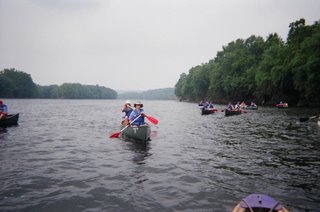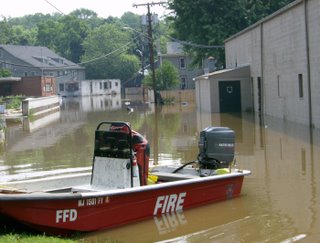THIS JUST IN:
The Delaware River Basin Commission
public hearing scheduled for July 19 was to take up the issue of banking excess release quantities of water in the NYC reservoirs, but I have just learned that this is off the table, mainly because New Jersey never signed on tothe agreement (which requires all parties) and the drought warnings were lifted. DRBC will have something posted to that effect very shortly.
Now back to our regular programming.Three relatively cool dry days in store before we return to hot and humid conditions on Sunday and all next week; no major storm events on the horizon.
I check both the National Weather Service (or Weather Channel) and AccuWeather every morning and evening, and I've found AccuWeather is slightly more accurate when it comes to predicting precipitation amounts. They use the same satellite data, but apparently use different modeling technique. When there is the threat of flooding, I go with whoever has predicted the highest rainfall amount.
As it appears the river and its tributaries will be falling back to near normal levels, attention will be turned to flood related topics, none more important than investigating the causes of the June 29 Flood. By far the most popular theory among the single-minded set is:
The reservoirs did it. Or more accurately, the people who control the reservoirs did it to US. Some people are specifically referring to the three large NYC Water Supply Reservoirs. The rest don't have a clue, they just like simple explanations, and the reservoir scapegoat is the easiest to grasp, and also will be the easiest to debunk, unless of course it turns out to be true.
And it won't in this case. The raw data can be found
here. A debunking viewpoint can be found in today's issue of the
Pocono Record that claims the reservoirs help control flooding.
The
development-caused-it single explanation is also lame, but since this flood was the result of so much rain in the Poconos, this needs to be looked at. The filling of wetlands is a major source of flooding in general, and this problem impacts the Poconos and its tributaries to the Delaware more than any other region in the 13,000 sq. mi. Delaware River Basin. That is because the Poconos are glaciated, and covered with water (streams, lakes, ponds, marshes, bogs etc.). Those nasty Nationwide 26 Permits the Army Corps gives out to developers may be significant part of the flood problem, both locally and furter downstream in the Lehigh and Lackawaxen Rivers.
Here is a story about the Nationwide Permit program and its impacts on Monroe County (in the heart of the Poconos). Ed Perry of US Fish & Wildlife Service is an expert in this area and does one hell of a presentation about how building in wetlands exacerbates flooding.
I believe all the single-reason explanations are BS. But it will take some research to make my own case. In the meantime there are many other more important issues, like how many property owners in the most vulnerable areas of the floodplain will pack it in, and how much money is available for buy-outs?
Regardless of what one thinks about the flooding and its causes, we wouldn't be having any of these discussions if so many didn't live on the river's turf (AKA the floodplain). The Delaware River will continue to rise up to reclaim its turf regardless of whatever manipulations are made to the system. Some municipalities, like the
Borough of Riegelsville, PA are getting wise and forbidding development in the floodplain. Most municipalities along the river have
pathetically weak floodplain regulations.
There are already many homes along the Lower Delaware River that have been for sale since April '05. Who would buy one now? How many more will be on the market? Such discussions are already underway in
Bucks County.








